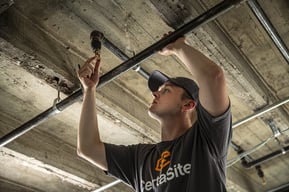
The leaves have fallen off the trees. There have been some frosty mornings. Winter is coming and the temperatures will continue to fall.
As cold weather approaches many areas throughout the country, fire sprinkler pipes and other fire protection systems become increasingly vulnerable to freezing. Not only does this make fire protection systems less effective and responsive, but it also increases the risk of severe water damage as a result of bursting pipes. Additionally, buildings located in milder climates may have even greater susceptibility in the event of a cold front since precautionary measures, such as winterizing, are more likely to have been overlooked.
Each year, fire protection systems should be winterized appropriately so they can withstand the cold temperatures. It's part of the annual maintenance and should be performed by professionals, but there are things you can do to ensure they work in the event of an emergency.
Fire Sprinkler Systems
Having a working and winterized fire sprinkler system during the winter months is crucial to minimizing fire damage along with reducing the potential for a busted pipe.
If your building is equipped with a wet pipe system, ensure the temperature in all areas of the dwelling are maintained at or above 40 degrees Fahrenheit. When you start to winterize your fire protection systems, pay close attention to exposed, often overlooked areas such as attics, garages, closets, etc. Search for isolated drafts or cold air leaks where there are fire sprinkler pipes. It may be necessary to replace windows or doors if they don’t prevent freezing temperatures from getting to the fire sprinkler system.
Should a fire sprinkler pipe burst, shut off the valve and keep it off until repaired.
Dry Fire Sprinkler Systems
If a location is likely to experience freezing conditions, you may want to install a dry pipe sprinkler system, if you don’t have one. Dry pipe systems are utilized in areas within dwellings that experience various fluctuations in temperature, such as attics or foyers.
Like all fire protection systems, dry sprinkler systems should have periodic inspections. It’s important to pay close attention to any standing water that may have the potential to freeze. This additional water usually comes from condensation and draining of the water within the fire sprinkler system. What happens when the water freezes within the system is often a costly result, including damage to the pipes and a potential to property flooding.
Additionally, monitoring the condition of the dry sprinkler system and the operation of the auxiliary drains should be part of the routine maintenance. Auxiliary drains should be operated daily after a dry sprinkler system operation, until several days pass with no discharge of water from the drain valve. Thereafter, it’s possible to decrease the frequency to weekly or longer intervals, depending on the volume of water discharged.
Additional Fire Protection Systems
If a facility has fire pumps and backflow preventers, they must have proper enclosures. They should be properly heated, as well. To reduce the risk of damage to a backflow preventer, it’s vital to take the following precautions:
-
Maintain a steady trickle of water during freezing conditions
-
Insulating the entire backflow preventer assembly
-
Make sure a freeze protection valve is installed
While backflow testing is carried out annually and is included as part of the fire sprinkler inspection, it’s important to take these steps during and before winter months.
Fire pumps are critical to the fire sprinkler system as they provide the main source of water. If a pump freezes due to inadequate maintenance and precautions, it may not produce enough water to lessen a fire.
Another system that is susceptible to cold weather issues is an anti-freeze system. These are typically used in smaller areas and temperatures do not get cold enough to exceed the protected temperature. Protected temperatures are dependent on the actual anti-freeze mix and need to be confirmed annually prior to the cold season to ensure there will be no issues. Starting September 30, 2022, the NFPA requirements are changing when it comes to use of antifreeze in wet fire sprinkler systems. It’s important you know what is changing so your systems is in compliance. You can learn the specific changes for the new requirements by visiting codes NFPA 25 and NFPA 13.
Certain fire extinguishers also need to be checked and possibly moved to warmer areas of the dwelling. Although water-based extinguishers (which contain an anti-freeze mix) are not common, this cannot easily be confirmed from the outside of the extinguisher. So, it’s essential to know the freeze rating, or swap these out for dry powder fire extinguishers during the colder months.
Lastly, don’t forget your emergency exit doors. During winter months, make sure all emergency exit doors are clear of ice, snow, or water. You don’t want anyone to slip and fall if there is an emergency and people have to exit quickly.
Winterizing your fire protection systems should be part of your routine maintenance. If you’re unsure what to do or have questions, it’s always best to work with your preferred fire protection company. They can inspect, maintain, and prepare all fire protection systems to stand up against the cold winter months.




